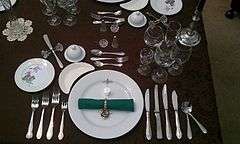Service à la russe
Service à la russe (French, "service in the Russian style") is a manner of dining that involves courses being brought to the table sequentially. It contrasts with service à la française ("service in the French style"), in which all the food is brought out at once in an impressive display. The Russian Ambassador Alexander Kurakin is credited with bringing service à la russe to France in the early 19th century, and it later caught on in England. This is now the style in which most modern Western restaurants serve food (with some significant modifications).
Place setting and service order

For the most correct service à la russe, the following must be observed:
The place setting (called a cover) for each guest includes a service plate, all the necessary cutlery except those required for dessert, and stemmed glasses for water, wines and champagne. Atop the service plate is a rolled napkin, and atop that is the place card. Above the plate is a saltcellar, nut dish, and a menu.
The cutlery to the right of the service plate are, from the outside in, the oyster fork resting in the bowl of the soup spoon, the fish knife, the meat knife and the salad knife (or fruit knife). On the left, from the outside in, are the fish fork, the meat fork and a salad fork (or fruit fork). (If both a salad and a fruit course are served, the necessary extra flatware must be brought out on a platter, as it is bad form to have more than three knives or forks on the table at once, the oyster fork excepted.)
Guests are seated according to their place cards and immediately remove their napkins and place them in their laps. Another view maintains that the napkin is only removed after the host has removed his or hers. In the same manner, the host is first to begin eating, and guests follow. Then the oyster plate is placed atop the service plate. Once that is cleared the soup plate replaces it. After the soup course is finished, both the soup plate and service plate are removed from the table, and a heated plate is put in their place. (The rule is as such: a filled plate is always replaced with an empty one, and no place goes without a plate until just before the dessert course.)
The fish and meat courses are always served from platters, because in correct service a filled plate is never placed before a guest, as this would indirectly dictate how much food the guest is to eat.
Directly before dessert everything is removed from the place settings but the wine and water glasses. Crumbs are cleared now. The dessert plate is then brought out with a doily on top of it, a finger bowl on top of that, and a fork and spoon, the former balanced on the left side of the plate and the latter on the right. Guests remove the doily and finger bowls, move them to the left of the plate and place the fork to the left side of the plate and the spoon to its right. Guests do not actually need to use the finger bowl, since they may have not used their fingers to eat with, unless they also had bread with the meal.
Eight-course meal
A traditional European full course dinner usually consists of the following:
- First course: a selection of hot or cold hors d'oeuvres, often includes caviar
- Second course: a variety of salads (not garden salad, see photos below)
- Third course: soup
- Fourth course: fish
- Fifth course: sorbet as a palate cleanser
- Sixth course: light green salad
- Seventh course: main course with one or more side dishes
- Eighth course: a selection of desserts with hot tea or coffee
Menu
A typical 14-course menu for a formal French dinner in service à la russe style is as follows:
- Oysters or clams on a half shell. Alternatively, fruit or caviar may be served
- Soup (each guest may choose between clear or thick)
- Radishes, celery, olives, and almonds (or relish)
- Fish, with potatoes and cucumbers with oil and vinegar
- Sweetbreads (or mushrooms)
- A roast with a green vegetable
- Frozen Roman punch (an alcoholic fruit punch thickened with egg whites)
- Game with salad
- Artichokes, asparagus, or spinach inside a shell of pastry
- Creamed sweet (e.g. a heavy pudding)
- Frozen sweet (e.g. a sorbet or ice cream)
- Cheeses with biscuits and butter
- Crystallized and stuffed dried fruits served with bonbons
- Coffee, liqueurs, cognac, and sparkling water
See also
References
- Cuisine Net Diner's Digest
- Martin, Judith; Miss Manners' Guide to Excruciatingly Correct Behavior: Freshly Updated. Norton, New York: 2005.
Footnotes
Further reading
- Patrick Rambourg, Histoire de la cuisine et de la gastronomie françaises, Paris, Ed. Perrin (coll. tempus n° 359), 2010, 381 pages. ISBN 978-2-262-03318-7